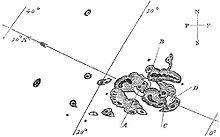Carrington event

The Carrington Event in 1859 caused the largest scientifically observed magnetic storm on earth. Richard Christopher Carrington , the most famous solar researcher at the time, had observed him among others . At that time, northern lights could even be seen in Rome, Havana and Hawaii , which normally only occur at higher latitudes .
1859: the strongest solar flare to date
From August 28 to September 4, 1859, several powerful solar flares occurred , which were observed by the astronomer Richard Carrington, among others. The ejected matter of the coronal mass ejections had a speed of over 2000 km / s. This reached the earth approx. 17.5 hours later. The most powerful geomagnetic storm to date was recorded on the night of September 1st. It led to auroras , which could even be seen in Rome, Havana and Hawaii. In the higher latitudes of Northern Europe and North America, such high voltages were induced in telegraph lines that strips of paper in the receivers were set on fire by sparks . The functioning of the global telegraph network that had recently been installed was severely impaired. Such phenomena were also observed in Central Europe, albeit in a weaker form.
Ice core investigations show that an event of this magnitude hits the earth every 500 years on average. According to the latest findings, however, these magnetic storms occur far more frequently without always hitting the earth.
After analyzing observation data from the STEREO probes , NASA researchers announced in 2014 that two years earlier, on July 23, 2012, the earth had narrowly escaped a “solar super storm”. The off-earth event was as powerful as the Carrington event of 1859.
Web links
- 1859 - Carrington Event. Working group Meteore eV
- Trudy E. Bell, Tony Phillips: A super solar flare. In: NASA Science. May 6, 2008 (English).
- Nadja Podbregar: The Super Eruption: The Carrington Event and the Discovery of the Solar Storms. In: Scinexx . April 26, 2013 .
Individual evidence
- ↑ Christian Reinboth: How dangerous are coronal mass ejections? A look back at the Carrington event of 1859. In: ScienceBlogs . April 30, 2009, accessed October 31, 2018 .
- ↑ Matthew Stein: When Disaster Strikes: A Comprehensive Guide for Emergency Planning and Crisis Survival . Chelsea Green Publishing, White River Junction (Vermont) 2011, ISBN 978-1-6035-8323-7 , p. 307.
- ↑ Donald Savage: NASA Scientist Dives into Perfect Space Storm. In: National Aeronautics and Space Administration / Jet Propulsion Laboratory. October 23, 2003, accessed October 31, 2018 .
- ^ Article in: Wiener Zeitung , August 31, 1859, p. 7 (online at ANNO ).
- ↑ a b New satellite data: Extreme solar storm missed the earth. In: Spiegel Online . July 24, 2014, accessed October 31, 2018 .
- ↑ Tony Phillips: Near Miss: The Solar Superstorm of July 2012. In: nasa.gov . July 23, 2014, accessed October 31, 2018 .
- ↑ DN Baker et al.: A major solar eruptive event in July 2012: Defining extreme space weather scenarios. Space Weather, Volume 11, pp. 585-591, doi : 10.1002 / swe.20097 , 2013